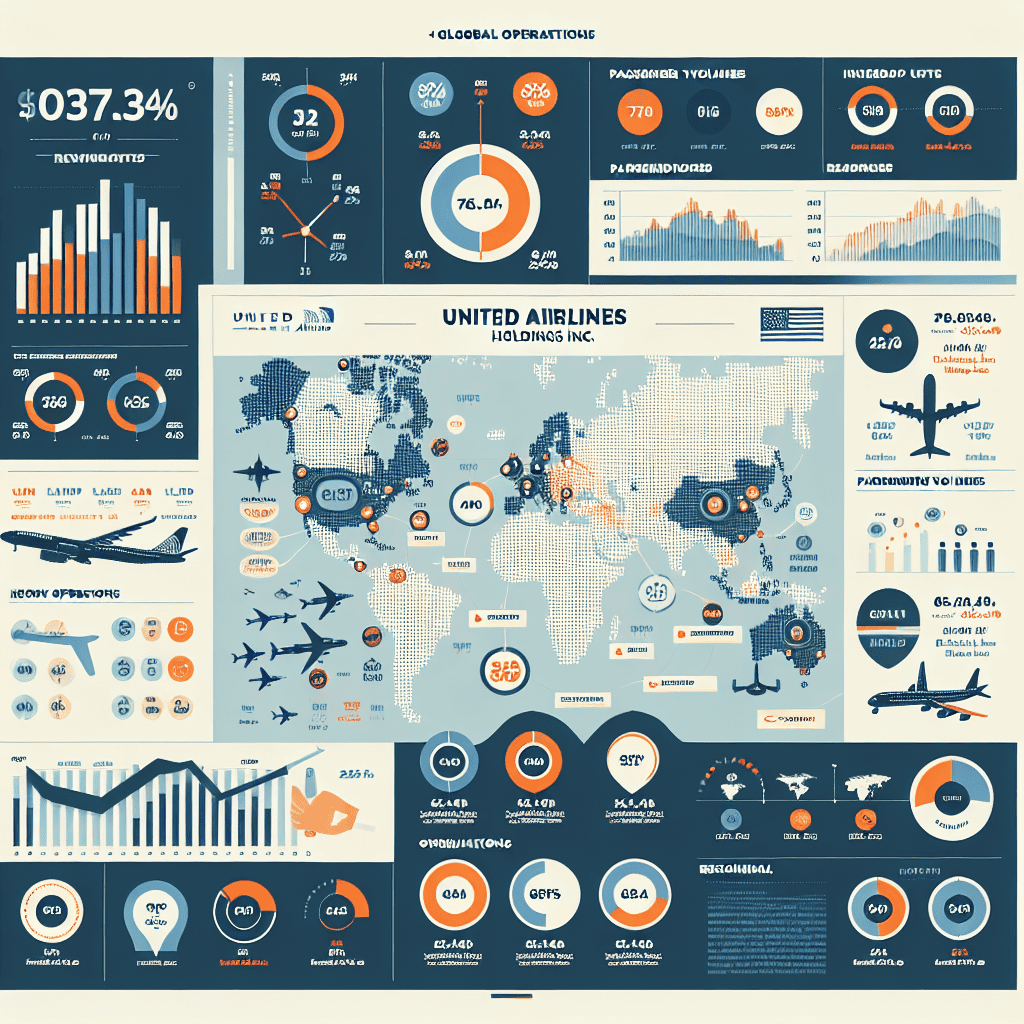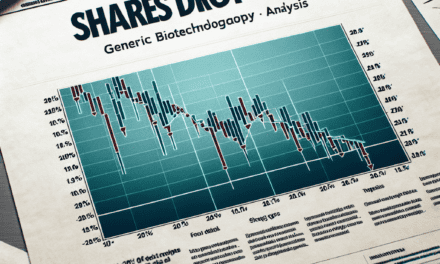“Navigating the Skies: A Deep Dive into United Airlines Holdings Inc.”
Introduction
**Introduction to Analyst Report: United Airlines Holdings Inc.**
United Airlines Holdings Inc. (NASDAQ: UAL) stands as one of the leading players in the global aviation industry, commanding a significant presence in both domestic and international markets. As the parent company of United Airlines, it operates an extensive network of routes, connecting major cities across the globe and serving millions of passengers annually. This analyst report delves into the financial performance, strategic initiatives, and market positioning of United Airlines Holdings Inc., providing a comprehensive overview of its operational strengths, challenges, and future prospects. With the aviation sector undergoing rapid changes due to technological advancements, regulatory shifts, and evolving consumer preferences, this report aims to offer valuable insights into how United Airlines is navigating these dynamics to maintain its competitive edge and drive shareholder value.
Overview Of United Airlines Holdings Inc.’s Financial Performance
United Airlines Holdings Inc., a major player in the global aviation industry, has demonstrated a dynamic financial performance over recent years. As the parent company of United Airlines, it operates an extensive network of domestic and international routes, positioning itself as a key competitor in the airline sector. To understand the financial health and trajectory of United Airlines Holdings Inc., it is essential to examine its revenue streams, cost management strategies, and overall market position.
In recent financial reports, United Airlines Holdings Inc. has shown a robust recovery from the challenges posed by the COVID-19 pandemic. The pandemic had a profound impact on the airline industry, leading to unprecedented declines in passenger numbers and revenue. However, as travel restrictions eased and consumer confidence returned, United Airlines experienced a significant rebound in demand. This resurgence is reflected in the company’s revenue growth, which has been bolstered by increased passenger traffic and strategic pricing adjustments.
Moreover, United Airlines Holdings Inc. has implemented several cost management initiatives to enhance its financial performance. These measures include optimizing fuel efficiency, streamlining operations, and renegotiating supplier contracts. By focusing on cost control, the company has been able to improve its operating margins, thereby strengthening its bottom line. Additionally, United Airlines has invested in modernizing its fleet, which not only reduces maintenance costs but also enhances fuel efficiency, contributing to long-term financial sustainability.
Transitioning to the competitive landscape, United Airlines Holdings Inc. faces intense competition from other major carriers such as Delta Air Lines and American Airlines. Despite this, United has managed to carve out a significant market share by leveraging its extensive route network and strategic alliances. The company’s membership in the Star Alliance, a global airline network, provides it with access to a vast array of international destinations, thereby enhancing its appeal to both business and leisure travelers. This strategic positioning has allowed United Airlines to maintain a competitive edge in the industry.
Furthermore, United Airlines Holdings Inc. has been proactive in addressing environmental concerns, which are increasingly important to investors and consumers alike. The company has committed to reducing its carbon footprint through various initiatives, including investing in sustainable aviation fuel and exploring innovative technologies. These efforts not only align with global sustainability goals but also position United Airlines as a forward-thinking leader in the aviation sector.
In terms of financial metrics, United Airlines Holdings Inc. has shown improvement in key areas such as earnings per share (EPS) and return on equity (ROE). These indicators reflect the company’s ability to generate profits and deliver value to shareholders. Additionally, United Airlines has maintained a strong liquidity position, ensuring it can navigate potential economic uncertainties and invest in future growth opportunities.
In conclusion, United Airlines Holdings Inc.’s financial performance illustrates a company that has effectively navigated the challenges of the past while positioning itself for future success. Through strategic revenue growth, cost management, competitive positioning, and a commitment to sustainability, United Airlines continues to strengthen its market presence. As the aviation industry evolves, United Airlines Holdings Inc. remains well-equipped to adapt and thrive, ensuring its continued relevance and profitability in the global market.
Key Metrics And Trends In United Airlines’ Quarterly Earnings
United Airlines Holdings Inc., a major player in the global aviation industry, has recently released its quarterly earnings report, providing valuable insights into its financial health and operational performance. This report is crucial for stakeholders, including investors, analysts, and industry observers, as it sheds light on the company’s current standing and future prospects. By examining key metrics and trends, we can gain a comprehensive understanding of United Airlines’ recent performance and strategic direction.
To begin with, United Airlines’ revenue figures are a primary focus in the quarterly earnings report. The company reported a notable increase in revenue compared to the same period last year, driven by a resurgence in travel demand as global economies continue to recover from the pandemic. This uptick in revenue is largely attributed to the easing of travel restrictions and the successful rollout of vaccination programs, which have collectively bolstered consumer confidence in air travel. Furthermore, United Airlines has strategically expanded its route network, tapping into underserved markets and increasing flight frequencies on high-demand routes, thereby capturing a larger share of the market.
In addition to revenue growth, another critical metric to consider is the company’s operating expenses. United Airlines has faced challenges in managing costs, particularly with the rising fuel prices that have impacted the entire aviation sector. However, the company has implemented several cost-control measures, such as optimizing fuel efficiency through fleet modernization and renegotiating supplier contracts. These efforts have partially mitigated the impact of increased fuel costs, allowing United Airlines to maintain a competitive edge in the industry.
Moreover, the company’s load factor, which measures the percentage of available seating capacity that is filled with passengers, has shown a positive trend. A higher load factor indicates improved efficiency in utilizing available resources, translating into better profitability. United Airlines has achieved this by employing dynamic pricing strategies and leveraging data analytics to forecast demand more accurately. Consequently, the airline has been able to adjust its pricing models and capacity planning to maximize revenue per available seat mile (RASM), a key performance indicator in the airline industry.
Transitioning to the balance sheet, United Airlines has made significant strides in strengthening its financial position. The company has focused on reducing its debt burden, which had escalated during the pandemic due to liquidity challenges. Through a combination of debt refinancing and strategic asset sales, United Airlines has improved its debt-to-equity ratio, enhancing its financial stability and flexibility. This prudent financial management is expected to support the company’s long-term growth initiatives and capital expenditure plans.
Looking ahead, United Airlines is poised to capitalize on emerging trends in the aviation sector. The company is investing in sustainable aviation fuel (SAF) and exploring innovative technologies to reduce its carbon footprint, aligning with the industry’s broader sustainability goals. Additionally, United Airlines is enhancing its customer experience by upgrading its digital platforms and introducing new service offerings, aiming to differentiate itself in a competitive market.
In conclusion, United Airlines’ quarterly earnings report highlights a period of recovery and strategic realignment. The company’s focus on revenue growth, cost management, and financial stability positions it well for future success. As the aviation industry continues to evolve, United Airlines’ proactive approach to addressing challenges and seizing opportunities will be instrumental in maintaining its leadership position. Stakeholders will undoubtedly keep a close watch on the company’s performance in the coming quarters, as it navigates the dynamic landscape of global air travel.
Impact Of Fuel Prices On United Airlines’ Profit Margins
United Airlines Holdings Inc., a major player in the global aviation industry, has consistently navigated the complex landscape of fluctuating fuel prices, which significantly impact its profit margins. As fuel costs represent one of the largest operating expenses for airlines, understanding their influence on United Airlines’ financial performance is crucial for stakeholders and analysts alike. In recent years, the volatility of fuel prices has posed both challenges and opportunities for the airline, necessitating strategic adjustments to maintain profitability.
To begin with, it is essential to recognize that fuel prices are inherently volatile due to a myriad of factors, including geopolitical tensions, natural disasters, and changes in global oil supply and demand. This volatility can lead to substantial fluctuations in operating costs for airlines. For United Airlines, which operates an extensive network of domestic and international flights, even minor changes in fuel prices can have a pronounced effect on its overall cost structure. Consequently, the airline’s management must continuously monitor fuel price trends and implement strategies to mitigate adverse impacts.
One of the primary strategies employed by United Airlines to manage fuel price volatility is hedging. By entering into financial contracts that lock in fuel prices for a specified period, the airline can protect itself against sudden price spikes. While hedging can provide a buffer against rising costs, it also carries risks, as incorrect predictions about future price movements can lead to financial losses. Therefore, United Airlines must carefully balance its hedging activities to optimize cost savings while minimizing potential downsides.
In addition to hedging, United Airlines has invested in fuel-efficient aircraft and technologies to reduce its overall fuel consumption. The introduction of newer, more efficient aircraft models into its fleet has enabled the airline to lower its fuel burn per passenger mile, thereby reducing its exposure to fuel price fluctuations. This strategic investment not only helps in managing costs but also aligns with broader industry trends towards sustainability and reduced carbon emissions.
Moreover, United Airlines has implemented operational efficiencies to further mitigate the impact of fuel prices on its profit margins. These include optimizing flight routes, improving load factors, and enhancing maintenance practices to ensure aircraft operate at peak efficiency. By streamlining operations, the airline can achieve cost savings that help offset the financial burden of high fuel prices.
Despite these efforts, it is important to acknowledge that external factors beyond the airline’s control can still exert significant pressure on profit margins. For instance, during periods of economic downturn or geopolitical instability, fuel prices may rise sharply, challenging even the most well-prepared airlines. In such scenarios, United Airlines may need to adjust its pricing strategies, such as implementing fuel surcharges or adjusting ticket prices, to maintain profitability.
In conclusion, the impact of fuel prices on United Airlines’ profit margins is a multifaceted issue that requires a proactive and dynamic approach. Through a combination of hedging, investment in fuel-efficient technologies, and operational efficiencies, the airline strives to mitigate the adverse effects of fuel price volatility. However, the inherent unpredictability of global fuel markets means that United Airlines must remain vigilant and adaptable to sustain its financial performance in the face of ongoing challenges. As the aviation industry continues to evolve, the airline’s ability to effectively manage fuel costs will remain a critical determinant of its long-term success.
United Airlines’ Strategic Initiatives For Market Expansion

United Airlines Holdings Inc. has been strategically positioning itself to expand its market presence in an increasingly competitive aviation industry. As the airline industry rebounds from the disruptions caused by the global pandemic, United Airlines is implementing a series of initiatives aimed at capturing a larger share of the market. These initiatives are designed to enhance operational efficiency, improve customer experience, and expand the airline’s global reach.
To begin with, United Airlines is focusing on fleet modernization as a cornerstone of its market expansion strategy. The company has committed to investing in new, fuel-efficient aircraft that not only reduce operational costs but also align with global sustainability goals. By upgrading its fleet, United Airlines aims to offer more reliable and comfortable services to its passengers, thereby enhancing customer satisfaction and loyalty. This move is expected to position the airline favorably against competitors who may be slower to adopt newer technologies.
In addition to fleet modernization, United Airlines is expanding its route network to tap into underserved markets. The airline has announced plans to increase its presence in both domestic and international markets, with a particular emphasis on emerging economies that are experiencing rapid growth in air travel demand. By establishing new routes and increasing flight frequencies, United Airlines seeks to provide more options for travelers and capture a larger share of the growing global travel market. This strategic expansion is supported by partnerships and alliances with other carriers, which enable United Airlines to offer seamless connectivity to a wider array of destinations.
Moreover, United Airlines is leveraging technology to enhance the customer experience, which is a critical component of its market expansion strategy. The airline has invested in digital platforms that streamline the booking process, provide real-time updates, and offer personalized services to passengers. By harnessing data analytics, United Airlines can better understand customer preferences and tailor its offerings accordingly. This focus on technology not only improves operational efficiency but also strengthens the airline’s brand image as a customer-centric organization.
Furthermore, United Airlines is committed to sustainability, recognizing that environmental responsibility is increasingly important to consumers. The airline has set ambitious targets to reduce its carbon footprint, including investing in sustainable aviation fuels and exploring innovative technologies such as electric and hybrid aircraft. By prioritizing sustainability, United Airlines aims to appeal to environmentally conscious travelers and differentiate itself in a market where sustainability is becoming a key competitive factor.
In parallel with these initiatives, United Airlines is enhancing its loyalty program to retain existing customers and attract new ones. The airline has introduced more flexible reward options and partnerships with other service providers, offering greater value to its frequent flyers. By strengthening its loyalty program, United Airlines seeks to build long-term relationships with its customers, which is essential for sustained market growth.
In conclusion, United Airlines Holdings Inc. is undertaking a comprehensive approach to market expansion through fleet modernization, network growth, technological innovation, sustainability efforts, and customer loyalty enhancement. These strategic initiatives are designed to position the airline as a leader in the industry, capable of meeting the evolving needs of travelers while navigating the challenges of a dynamic market environment. As United Airlines continues to implement these strategies, it is poised to achieve significant growth and maintain its competitive edge in the global aviation sector.
Analysis Of United Airlines’ Customer Satisfaction And Service Quality
United Airlines Holdings Inc., a major player in the global aviation industry, has long been under scrutiny for its customer satisfaction and service quality. As the airline industry continues to evolve, understanding the factors that influence customer perceptions and experiences is crucial for maintaining competitive advantage. United Airlines, like many of its counterparts, faces the challenge of balancing operational efficiency with the delivery of high-quality service. This analysis delves into the current state of United Airlines’ customer satisfaction and service quality, examining both the strengths and areas for improvement.
To begin with, United Airlines has made significant strides in enhancing its customer service over recent years. The airline has invested heavily in upgrading its fleet, improving in-flight amenities, and expanding its route network. These efforts have been aimed at providing a more comfortable and convenient travel experience for passengers. For instance, the introduction of newer aircraft with advanced seating options and enhanced entertainment systems has been well-received by customers, contributing positively to their overall satisfaction. Additionally, United’s MileagePlus loyalty program has been a key factor in retaining customer loyalty, offering a range of benefits that appeal to frequent flyers.
However, despite these improvements, United Airlines still faces challenges in consistently delivering high-quality service. One of the primary areas of concern is the variability in customer service experiences. While some passengers report positive interactions with staff, others have encountered issues such as delayed flights, lost baggage, and unsatisfactory responses to complaints. This inconsistency can be attributed to several factors, including operational disruptions, staffing shortages, and the inherent complexities of managing a large-scale airline operation. Consequently, addressing these issues is essential for United to enhance its reputation and improve customer satisfaction.
Moreover, the airline industry as a whole has been impacted by external factors such as the COVID-19 pandemic, which has further complicated service delivery. United Airlines, like many others, had to adapt quickly to changing travel restrictions and health protocols. While the airline implemented measures to ensure passenger safety, such as enhanced cleaning procedures and flexible booking policies, these changes also introduced new challenges. For example, the need for social distancing and reduced in-flight services may have affected the overall passenger experience, leading to mixed reviews from customers.
In addition to operational challenges, United Airlines must also navigate the digital transformation of the industry. The increasing reliance on technology for booking, check-in, and customer service interactions presents both opportunities and challenges. On one hand, digital tools can streamline processes and enhance convenience for passengers. On the other hand, technical glitches or a lack of user-friendly interfaces can lead to frustration and dissatisfaction. Therefore, investing in robust digital infrastructure and ensuring seamless integration with customer service operations is vital for United to meet the evolving expectations of tech-savvy travelers.
In conclusion, while United Airlines has made commendable efforts to improve its customer satisfaction and service quality, there remains room for growth. By addressing inconsistencies in service delivery, adapting to external challenges, and embracing digital innovation, United can enhance its reputation and strengthen its position in the competitive airline industry. As customer expectations continue to rise, maintaining a focus on delivering a consistently high-quality travel experience will be key to United Airlines’ long-term success.
Competitive Positioning Of United Airlines In The Aviation Industry
United Airlines Holdings Inc. occupies a significant position within the aviation industry, characterized by its extensive network, strategic alliances, and continuous efforts to enhance customer experience. As one of the major players in the global airline market, United Airlines has developed a competitive edge through a combination of factors that contribute to its robust market presence. To begin with, United Airlines benefits from a comprehensive route network that spans across six continents, allowing it to serve a diverse range of destinations. This extensive reach not only facilitates connectivity for passengers but also positions the airline as a preferred choice for both leisure and business travelers. By offering a wide array of routes, United Airlines can effectively capture a larger market share and cater to the varying needs of its customer base.
In addition to its expansive network, United Airlines has strategically formed alliances and partnerships that bolster its competitive positioning. As a founding member of the Star Alliance, the world’s largest global airline alliance, United Airlines can offer its customers access to a vast network of partner airlines. This collaboration enhances the airline’s ability to provide seamless travel experiences, including code-sharing agreements and coordinated schedules, which are crucial for maintaining customer loyalty and attracting new passengers. Furthermore, these alliances enable United Airlines to optimize its operational efficiency by sharing resources and reducing costs, thereby strengthening its financial performance.
Moreover, United Airlines has consistently invested in modernizing its fleet and enhancing its in-flight services, which are critical components of its competitive strategy. By incorporating newer, more fuel-efficient aircraft, the airline not only reduces its environmental footprint but also lowers operational costs, which can be passed on to customers in the form of competitive pricing. Additionally, United Airlines has focused on improving the overall passenger experience by upgrading cabin interiors, expanding in-flight entertainment options, and offering premium services such as United Polaris for long-haul international flights. These enhancements are designed to meet the evolving expectations of travelers and differentiate United Airlines from its competitors.
Furthermore, United Airlines’ commitment to technological innovation plays a pivotal role in its competitive positioning. The airline has embraced digital transformation by implementing advanced technologies that streamline operations and enhance customer interactions. For instance, the use of mobile applications and self-service kiosks has simplified the check-in process, while real-time data analytics enable the airline to optimize flight schedules and improve on-time performance. By leveraging technology, United Airlines can deliver a more efficient and personalized travel experience, which is increasingly important in today’s competitive aviation landscape.
However, it is essential to acknowledge the challenges that United Airlines faces in maintaining its competitive edge. The aviation industry is highly susceptible to external factors such as fluctuating fuel prices, regulatory changes, and geopolitical tensions, which can impact operational costs and demand for air travel. Additionally, the rise of low-cost carriers presents a formidable challenge, as these airlines continue to attract price-sensitive customers with their budget-friendly offerings. To address these challenges, United Airlines must remain agile and adaptable, continuously refining its strategies to sustain its market position.
In conclusion, United Airlines Holdings Inc. has established a strong competitive position within the aviation industry through its extensive network, strategic alliances, fleet modernization, and technological innovation. While challenges persist, the airline’s proactive approach to enhancing customer experience and operational efficiency positions it well to navigate the dynamic landscape of the aviation sector. As United Airlines continues to evolve, its ability to leverage its strengths and address emerging challenges will be crucial in maintaining its status as a leading global airline.
Future Outlook And Growth Prospects For United Airlines Holdings Inc
United Airlines Holdings Inc., a major player in the global aviation industry, has been navigating a complex landscape marked by both challenges and opportunities. As the world gradually recovers from the disruptions caused by the COVID-19 pandemic, the future outlook and growth prospects for United Airlines are of significant interest to investors and industry analysts alike. The airline industry, having faced unprecedented setbacks, is now poised for a period of recovery and transformation, and United Airlines is strategically positioned to capitalize on these emerging trends.
To begin with, the global demand for air travel is on an upward trajectory, driven by the easing of travel restrictions and a resurgence in both leisure and business travel. United Airlines, with its extensive network and strategic alliances, is well-equipped to meet this growing demand. The airline’s commitment to expanding its route network, particularly in international markets, is a testament to its forward-looking strategy. By increasing its presence in high-growth regions, United Airlines aims to capture a larger share of the global travel market, thereby enhancing its revenue streams.
Moreover, United Airlines has been investing significantly in fleet modernization and sustainability initiatives. The airline’s focus on upgrading its fleet with more fuel-efficient aircraft not only aligns with global environmental goals but also positions the company to benefit from cost savings in the long term. This strategic move is expected to improve operational efficiency and reduce the airline’s carbon footprint, which is increasingly important to environmentally conscious travelers and investors. Furthermore, United Airlines’ commitment to achieving net-zero emissions by 2050 underscores its dedication to sustainable growth.
In addition to fleet modernization, technological advancements are playing a crucial role in shaping the future of United Airlines. The airline is leveraging digital innovations to enhance customer experience and streamline operations. From implementing advanced booking systems to utilizing data analytics for personalized services, United Airlines is embracing technology to stay competitive in a rapidly evolving industry. These efforts not only improve customer satisfaction but also contribute to operational resilience, enabling the airline to adapt swiftly to changing market dynamics.
However, it is important to acknowledge the challenges that United Airlines may face in its growth journey. The airline industry is inherently susceptible to external factors such as fluctuating fuel prices, geopolitical tensions, and economic uncertainties. United Airlines must remain vigilant and agile in navigating these potential headwinds. Additionally, the competitive landscape is intensifying, with low-cost carriers and other major airlines vying for market share. To maintain its competitive edge, United Airlines must continue to differentiate itself through superior service offerings and strategic partnerships.
Looking ahead, United Airlines’ growth prospects are further bolstered by its strong financial position and strategic initiatives. The airline’s robust balance sheet provides a solid foundation for future investments and expansion plans. Moreover, United Airlines’ focus on enhancing its loyalty program and strengthening customer relationships is expected to drive repeat business and brand loyalty. By fostering a customer-centric culture, the airline aims to build long-term relationships with its passengers, thereby ensuring sustained growth.
In conclusion, United Airlines Holdings Inc. is well-positioned to capitalize on the recovery and growth opportunities in the aviation industry. Through strategic investments in fleet modernization, sustainability, and technology, the airline is poised to enhance its competitive position and deliver value to its stakeholders. While challenges remain, United Airlines’ proactive approach and commitment to innovation provide a promising outlook for its future growth prospects. As the airline continues to navigate the evolving landscape, its strategic initiatives are likely to yield positive results, reinforcing its status as a leading player in the global aviation market.
Q&A
1. **What is the current stock rating for United Airlines Holdings Inc.?**
– The stock rating varies by analyst, but it is commonly rated as “Buy,” “Hold,” or “Sell” based on recent performance and market conditions.
2. **What are the key financial metrics for United Airlines Holdings Inc.?**
– Key financial metrics include revenue, net income, earnings per share (EPS), and operating margin.
3. **What are the growth prospects for United Airlines Holdings Inc.?**
– Growth prospects are influenced by factors such as market demand, fleet expansion, and strategic partnerships.
4. **What risks are associated with investing in United Airlines Holdings Inc.?**
– Risks include fuel price volatility, regulatory changes, and economic downturns affecting travel demand.
5. **What is the target price for United Airlines Holdings Inc. stock?**
– The target price varies by analyst but is typically based on projected earnings and market conditions.
6. **How does United Airlines Holdings Inc. compare to its competitors?**
– Comparisons are made based on market share, route network, customer service, and financial performance.
7. **What recent developments have impacted United Airlines Holdings Inc.?**
– Recent developments may include new route announcements, changes in leadership, or strategic initiatives.
Conclusion
United Airlines Holdings Inc. has demonstrated a robust recovery trajectory post-pandemic, driven by increased passenger demand and strategic operational adjustments. The company has focused on expanding its route network, enhancing customer experience, and implementing cost-control measures to improve profitability. Despite facing challenges such as fluctuating fuel prices and potential economic downturns, United Airlines remains well-positioned in the competitive airline industry. Its commitment to sustainability and innovation further strengthens its market position. Investors should consider both the opportunities and risks associated with the airline’s growth strategy and external market conditions.





